We independently evaluate all recommended products and services. Any products or services put forward appear in no particular order. If you click on links we provide, we may receive compensation.
I’ve been carrying and reviewing knives long enough now that I’ve pretty much nailed down “my thing.” Knives, to me, have a bell curve of enjoyment. At the bottom end of the curve are knives so cheaply made or poorly designed that there’s no joy in owning or using them, or worse yet, danger in relying on them as tools. At the far end of the bell curve are knives so expensive, and rare, and perfect that you’re compelled to not actually use them for fear of damaging a valuable investment.

Which brings us to Civivi. Civivi is the budget line of WE Knives, a maker of premium production knives in Yangjiang (Guangdong province) China. Civivi makes their knives out of more affordable materials (think G10 and tool steels rather than titanium and exotic steels) but they’re made to the same exacting production standards as WE Knives. Most of Civivi’s product line falls in the sweet spot of this affordability bell curve, including the massively popular Elementum we tested previously.

Today we’re looking at the Civivi Odium, which is a collaboration with them that’s been designed by Ferrum Forge. FF has collaborated with WE a number of times since they launched their Pro Line products in 2018, scaling back on high dollar limited run customs (so, the far right side of the aforementioned bell curve) to focus more on high quality, more affordable knives. This has included both FFKW branded knives made by WE, as well as WE-branded knives designed by FFKW, and now with the introduction of the Odium we have a Civivi-branded knife designed by Ferrum Forge.
This means you get the design chops of a Williamson-designed knife, and the production tolerances of a WE knife, at the affordable price of a Civivi – this knife retails for only $52. This is the phrase I kept uttering to myself during my testing of the Odium – “how does this knife only cost $52?” It brings a lot of the feel of a custom designer knife into your pocket for very little cash. But, as it turns out, it’s also a very compelling EDC option. Let’s take a closer look.
Key Specs: Civivi Odium
The Blade
The Odium is a small knife, with a suitably small blade. Measuring just 2.65” long with a 2.25” cutting edge, the Odium is short enough to classify as a “Chicago carry” knife – meaning a knife well under 3” long for areas with draconian knife laws. Blade shape is a broad drop point, with a mostly continuous curve of the spine to the tip. The sharpened edge is all belly as well, making the most of the short cutting area for roll cuts. A run of shallow jimping at the base of the spine provides added grip. Civivi went with a flat grind for this blade, which is full height for about the first third of the blade then cuts away gradually to leave the flats where the thumb hole is cut out. Blade finish looks to be a bead blast with a light stonewash on top of it, leaving the surface a matte grey color. The forward finger choil is quite pronounced on this blade, taking up 16% of the blade’s length, and the handling of the edge intersecting the choil is perfect – no beard, no flared out end, just a smooth intersection of the edge and the grip. The blade is fairly thin, measuring 0.12” across the spine and 1.00” tall at the widest point.
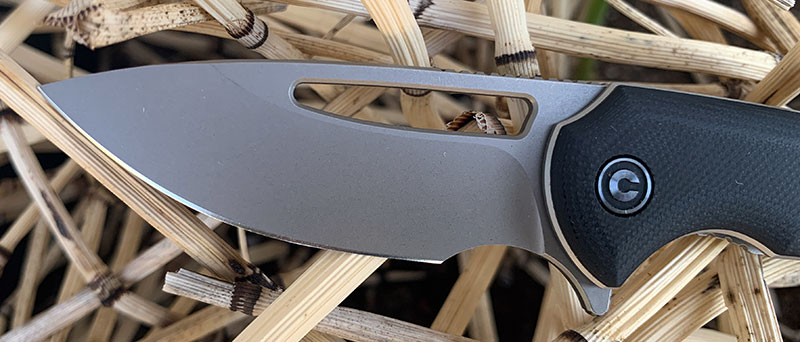
Blade steel on the Odium is D2, which Civivi says is heat treated to somewhere in the range of 59-61 (HRC). Some people aren’t fans of D2 – and to be fair, in my experience it takes a patina or discoloration very easily – but for this price range, I think D2 offers the best balance of performance and cost. It certainly holds an edge much longer than fully stainless steels available around this price range, like Sandvik 12c27 or 8Cr13MoV. The basic measure of how well a steel will hold an edge is carbon content – I know, there’s more to it than that – and D2 has carbon in far greater amounts than other budget steels. At 1.55%, it has nearly triple that of 12c27, double that of 8Cr13MoV, and still has almost 50% more than VG10 – which is usually found in more expensive knives. Of course, it has less chromium than all of those, which is what determines corrosion resistance. So if you value edge retention it’s great, but if you live in a jungle or near the ocean it’s less great.
Deployment & Lockup
WE knows how to make knives open well, which means that Civivi makes knives that open well. 10 years ago, this was the kind of action you’d only find on $200+ high end knives. Now, it’s basically par for the course with a Civivi. The Odium uses ceramic ball bearings in a caged cassette for deployment, and its slicker than Johnny Bravo’s hair to deploy. The interface with the flipper tab is unique, with the leading edge of the spine cut away in an arc to allow your finger to sit flat on the forward edge of the flipper tab. Jimping on the tab provides traction allowing you to push-button pop the blade open easily. Since the blade is fairly light, it won’t drop shut under its own weight against the tension of the detent ball, but one firm shake will get it to close – really crazy levels of action for a $52 mass produced knife.
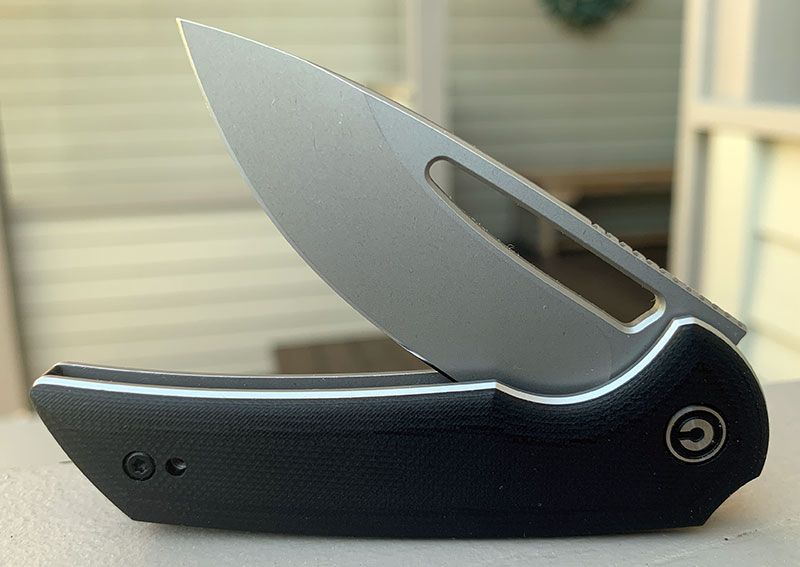
There are no faults to be found with the lock, either: it’s nothing exotic, just a stainless liner lock with a run of shallow jimping on the release for your thumb, but it works perfectly. Lockup is very early, with a firm flick putting the lockbar about 15% across the surface of the tang, so there’s a lot of life built into this lock. I never experienced any lock stick whatsoever, and blade play is notable only by its absence – either vertically or horizontally. The Odium uses an external stop pin to locate the blade when open and closed, anchored in the stainless scales for strength.
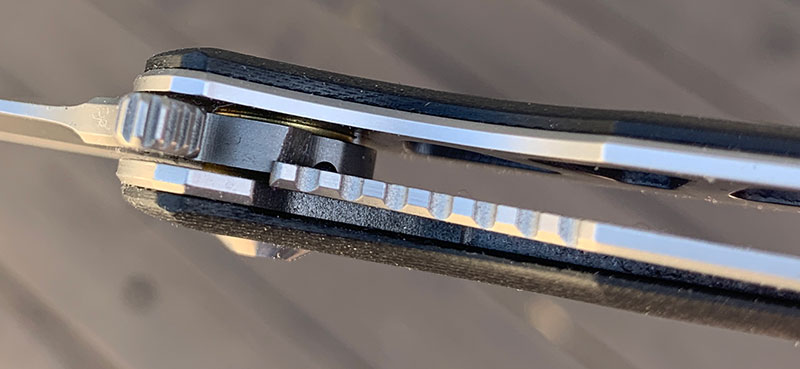
What is odd about the Odium’s deployment is that thumb hole – it doesn’t work. Now maybe I’m doing it wrong, but I’ve been fiddling with knives for about 15 years now and I’d like to think I know every knife-opening trick in the book, and I can’t deploy this knife via the thumb hole from either the front or the rear (a la Spydie flick with the middle finger.) The detent strength is way too high and the access to the hole is too occluded to get the right angle on it. Obviously the detent has to be strong for the flipper to do its thing, so this is no crime against the earth, but if you’re looking for a knife with two actual deployment methods this ain’t it – think of the thumb hole as a stylistic choice, not a functional one. I suppose it does remove some weight as well.
Features, Fit & Finish
Wow, not really much bad to say about the Odium, even if you’re looking for it. The liners sit ever so slightly proud of the scales, a trick to give the handles more of a rounded, organic feel in the hand – also shared by the Spyderco Gayle Bradley folder. The scales themselves are G10, but they’ve been contoured and smoothed out so much they look and feel more like canvas micarta than a kind of advanced plastic – extremely smooth at every edge and corner. The edges of the steel liners are also chamfered at an angle to make them smoother in the hand, all the way around the perimeter of the scales.
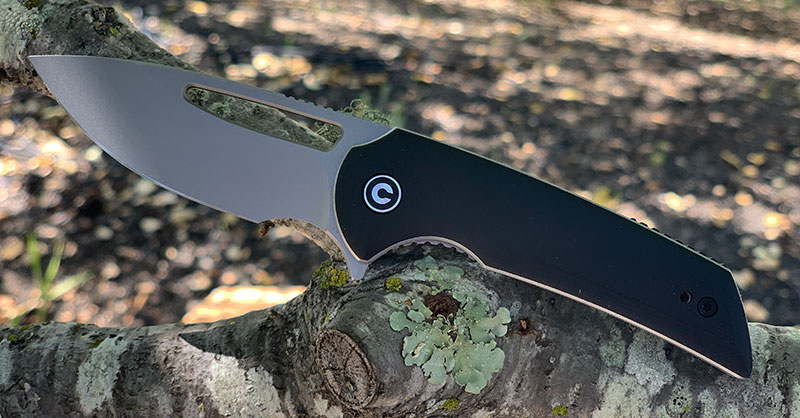
Construction is minimalistic – the knife is held together by the pivot pin and a single body screw per side, along with an additional screw on whichever side the clip is mounted on to secure it (thus the blank hole on the show side scale, which would serve as the clip mounting hole if you swapped the clip around.) The pivot is a Chicago style screw with the female side having an engraved “C” logo. In fact, other than the “C” logo the only branding is on the opposite side of the blade up against the spine denoting the Odium’s Ferrum Forge origins with a stylized “FF Design” logo – no billboarding here. The liners are heavily skeletonized to cut down on weight, and there’s a textured backspacer that stands slightly proud of the liners at the rear.
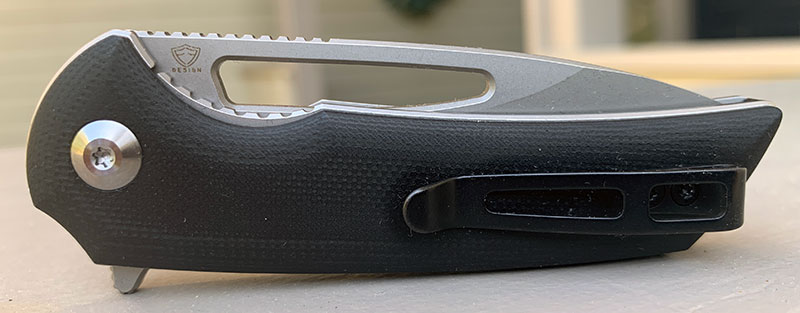
The pocket clip is nothing fancy, probably the only thing on the Odium that gives you the impression this isn’t an expensive knife – that’s not a dig against the clip, it works fine. But it’s just your usual bent steel clip painted black, a deep carry design with a square folded over top giving the seam of your pocket plenty of room. It looks to be the same clip that was on the Civivi Elementum, and I wasn’t in love with it there either. But it works fine, and is configured for ambidextrous tip-up carry – with one screw dedicated to the clip and another serving as a clip and a body screw. It just seems cheap and bolted on as an afterthought.
Field Test
The Odium is a real pleasure to carry and use, especially for the price point. It’s quite light – 2.5 ounces, so that combined with the deep carry spring clip means it rides in the pocket well. It’s kind of wide for its overall size – due to the contoured scales, it measures in at 0.43” across, so it does take up some depth, but it’s short length when closed (3.54”) means there’s still space in your pockets for a phone or other accoutrement below it. It can also (just barely) fit in a fifth pocket on jeans, but I found it to be a little tall and chunky for that task. Still, all the contoured scales and smoothed edges mean you’re not grimacing when you reach into the pocket to pull out some loose change around it.
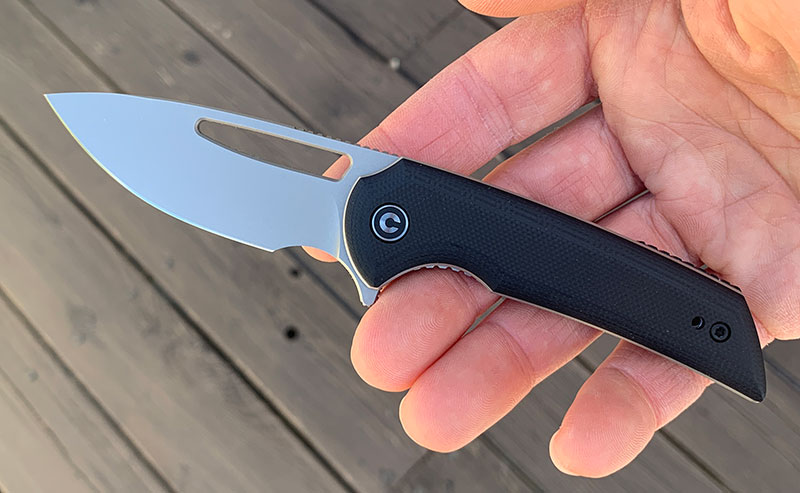
I like the ergonomics on this knife quite a lot. Yes, that forward finger choil does take up a lot of the blade’s cutting edge percentage wise – about 16% of it – but having a pronounced finger choil combined with a short blade means you have a very high degree of control over the edge since you have a lot of leverage – again, sorry for all the math, but in the forward grip 64% of the overall length when open is handle, so you can move the blade very precisely. The handles are also very comfortable, the gentle swell in your palm makes the grip feel natural rather than pinched, and that long handle to cutting edge ratio makes this relatively short knife a solid four-finger grip when you’re pulling material against the blade to cut it.
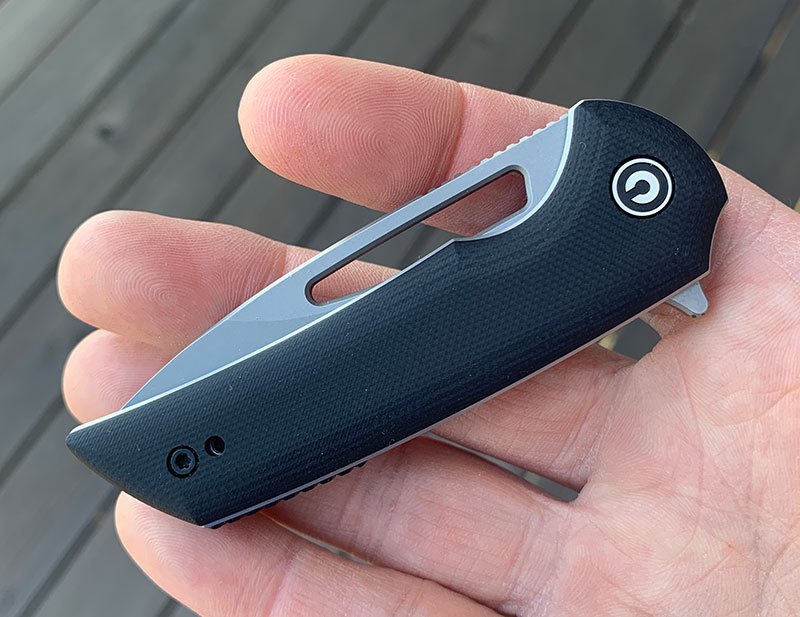
Alternatively, if you’re using it to precisely open packaging, a pinch grip on the pivot with your thumb and middle finger puts the tip of your index finger smack dab on the jimping on the spine, and the drop point shape puts the tip of the blade far enough down to making box cutting an easy task. The blade geometry with the tall flat grind maximizes cutting performance by thinning the blade out behind the edge. How does the D2 blade work? Well, considering D2 steel has been used in knives for approximately 60 years at this point, I won’t have any interesting commentary to add – it’s tough, it doesn’t chip easily, it doesn’t hold an edge as long as modern high end steels, and it’s not too bad to sharpen using diamond abrasives. Sort of par for the course for this price point.
Alternatives
All these knives available at BladeHQ.
Well, the most obvious alternative is the Ferrum Forge Mini Archbishop. For now the Odium only comes in one configuration – G10 scales and D2 steel – while the Mini Archbishop comes in two steel choices and G10 or Micarta scales. The more comparable is the less expensive version in 9Cr18Mo with G10 scales – the new upgraded variant with Micarta and Nitro-V steel runs $90 while the 9Cr version is $75. 9Cr18Mo is a Chinese domestic-made steel that’s a step up from 8Cr13MoV, having considerably higher carbon and chromium content as well as other trace elements – although it’s still lower carbon than D2, coming in at around 1% versus D2’s stout 1.55%. It’s much more corrosion resistant with its high chromium content (16-18% is very high) but it won’t hold an edge quite as long.
Comparing the knives themselves, they have similar blade and overall lengths (2.65/6.19 for Civivi, 2.75/6.375 for FF) and similar weights (Civivi 2.5, Archbishop 2.41) but the Archbishop has a nicer pocket clip and less pronounced contouring on the scales. They are remarkably similar knives, and they’re both made by the same company, so you can boil this one down to stylistic preference or steel choice. The Nitro-V version comes with Micarta scales, and this new steel is similar in performance to AEB-L or Sandvik 14c28n – a modern stainless steel with high corrosion resistance and fine grain structure for a super clean edge and an emphasis on toughness over edge retention.
For less direct comparisons, we’ll look at some other knives in the sub-$100 range, with 2-3” blades and flipper deployment – of which there are quite a lot in recent years. $55 will get you the basic G10 version of the SOG Terminus XR, with a 3” drop point blade in cryo-treated D2 steel. I was a big fan of the original Terminus XR– with carbon fiber and CTS-BDZ1 (now replaced with S35VN), and the budget version is a screaming deal at this price. It’s a bit heavier at 3.32 ounces owing to the more complicated lock system and full stainless liners. SOG’s XR-Lock remains a favorite for smooth ambidextrous deployment, and the only thing marring this otherwise perfect budget knife is the hateful pocket clip.

Another one to consider at this price and size range is the CRKT Pilar Large, an upgrade to the fan-favorite Pilar. With a 2.6” sheepsfoot blade in D2 with a forward finger choil, G10 scales, and a hefty stainless framelock, the Pilarge has a lot of character. IKBS bearings make deployment fast, with a choice between a flipper tab and an oblong thumb hole. It’s also heavier than the Odium at 3.52 ounces, but lighter on the wallet at $49.

Another intriguing option is the new Vanguard version of the Justin Lundquist-designed Kizer Feist, a knife we reviewed in the past in its original Bladesmith form. That knife had solid titanium handles and a stonewashed CPM S35VN blade, while the Vanguard line knives use more affordable materials- in the Feist’s case, grey G10 and a CTS-BD1N blade. While those might be a step down, the bent steel deep carry clip is a definite step up, as is the price: $79. The Feist still retains its front flipper deployment via super-smooth ball bearings, and has a liner lock. It has similar dimensions to the Odium, with a 2.875” blade and 6.5” overall length as well as a 2.68 ounce weight. I loved the original Feist and I’ve no doubt the Vanguard version would be excellent as well.
Wrap-Up
It’s not hard to like the Odium. Even if it was a boring anodyne design, if it was built and functioned this well for $52 it would still be a home run in my book. But it’s not; it has that immediately recognizable Ferrum Forge design that makes you stare at it for a bit longer than necessary every time you pull it out.
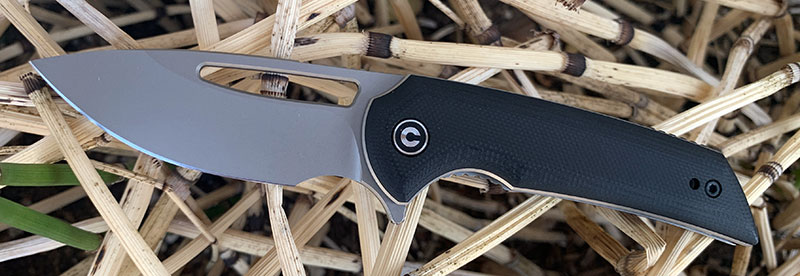
It also makes the Ferrum Forge branded Mini Archbishop seem overpriced, on a smaller scale but in the same way that the ZT-branded Emerson knives made actual Emersons seem silly. Although it uses basically the same materials and is made at the same place for about the same price as the Elementum, I found myself liking the Odium a lot more because it’s actually interesting. Really hard to go wrong with this one, I’d say. You can read more Civivi knives reviews on the Conspirator, Elementum, and Vision FG.
- Ferrum Forge design at Civivi price, typical WE Knives build quality, excellent flipper deployment, light and pocketable, great ergonomics
- The thumb hole doesn’t work as a thumb hole, mediocre pocket clip
Civivi Odium
Quality/Performance - 75%
Value for Money - 88%
82%
The Civivi Odium is another great budget knife to add to your collection.





